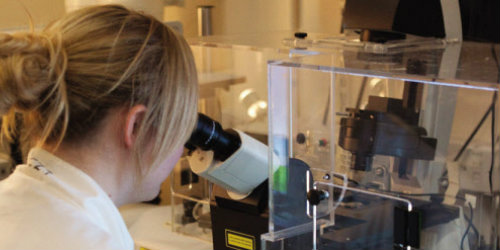Neurotransmitters may be behind debilitating headaches
Motivation, addiction, sleep, high blood pressure – one family of neurones is implicated and if researchers at the University of Bristol hypothesise correctly, migraines could also be added to that list.
Noradrenergic neurones are vastly different to the textbook image of a neurone, explains Dr Anja Teschemacher, for whom they are an on-going source of fascination. She describes them as an entirely different “beast”. Compared with the showcase neurone as found in the cortex, the noradrenergic neurone’s cell body is smaller and rounder, with lots of branching processes emanating from it that reach out to the entire brain and down the spinal cord.
Most importantly, the way in which they connect to other neurones is strikingly different and it is this difference that Dr Teschemacher is interested in exploring. The processes of noradrenergic neurones shy away from direct contacts to other neurones but rather address their signals to a wider group of receiving cells.
So, how is signalling regulated in a physiologically meaningful way so that some areas will get the message and some will remain un-stimulated?
There are estimated to be between 25,000 and 50,000 noradrenergic neurones in the human locus coeruleus alone, the part of the brainstem involved in physiological responses to stress and panic, amongst other functions. As such, the locus coeruleus is the principal site for brain synthesis of noradrenaline, a neurotransmitter.
Noradrenaline is contained in small round compartments, called vesicles, inside the neurones which indicate that it will be released by exocytosis, the process by which a cell directs the contents of secretory vesicles out of the cell membrane and into the extracellular space.
Given that this is the way in which other cells interact, the likelihood of this process being applicable to noradrenergic neurones had been anticipated. But until Dr Teschemacher’ s group put it to the test, it had never been properly measured.
The revelation came partly as the result of an amalgamation of techniques already familiar to biomedicine – but applied in a novel way. Using a viral vector, Dr Teschemacher highlighted noradrenergic neurones by a fluorescent protein that emits bright green light, while patch clamping – a technique for determining ion flow across the membrane of a cell by use of a micropipette – allowed them to observe activity at the cellular level. Other microelectrode techniques provided measurements of transmitter release.
It was this that led Dr Teschemacher to find that the noradrenergic neurones were releasing transmitter in extraordinarily large portions. Dr Teschemacher then found a way of using electron microscopy to show that, in fact, the noradrenaline containing vesicles are much larger than previously thought.
She adds: “One thing that we’re now observing is that in a hypertensive animal model, in some of the brain areas where these neurones are, we find larger vesicles containing more neuropeptides and more noradrenaline. That is definitely a question to follow up in terms of asking what causes high blood pressure – we still don’t understand why some people develop high blood pressure and some don’t. It seems to be a combination of a genetic component and some lifestyle factors. As a group we hypothesise that it’s driven from the brain and the brain’s regulation of the cardiovascular system. I believe the noradrenergic neurones have something to do with it.”
This evolution in the understanding of the noradrenergic neurones has prompted Dr Teschemacher to look at the differences in modulation and transmitter release. It has further led to an exploration of the role of these neurones in migraine – a debilitating condition that remains poorly understood.
“Astrocytes, which are traditionally thought of as ‘brain glue’, a cell type that simply feeds the neurones and mops up the mess, actually seem to play a more active signalling role than originally thought,” explains Dr Teschemacher, Senior Lecturer in the School of Physiology and Pharmacology. “Looking at the locus coeruleus, it seems that astrocytes talk directly to noradrenergic neurones and make them release transmitters.”
Her lab is using patch clamping and electrochemical techniques to measure the volume of transmission, which they anticipate should reveal the extent to which the cross-talk between astrocytes and noradrenergic neurones affects migraines.
It’s a novel approach that could prove to be an insightful break from the norm. Dr Teschemacher adds: “Quite often people formulate the questions according to what techniques they have readily to hand but I prefer to do it the other way around – to come up with novel questions and then formulate new techniques. It takes much longer, and the process can be very unpredictable, new techniques don’t necessarily work the first time around. But I’m interested in exploring the ways in which such a universal and vital modulator in the brain as noradrenaline can lead to such differentiated, subtle and physiologically meaningful functions. “
